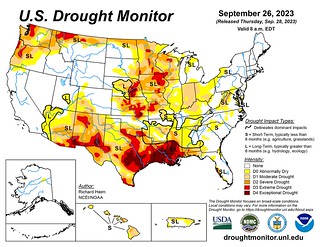Barge freight rates rise as Mississippi River levels continue to sink
“If heavy rainfall does not cause river levels to improve, Southern producers could again face unexpected losses due to the effects of falling river levels on barge freight rates and, thus, basis.” James Mitchell
By Mary Hightower
U of A System Division of Agriculture
Sept. 28, 2023
Fast facts
- Mississippi River drops to minus 10.6 feet
- Mitchell: Dropping basis “could have huge implications on farm profitability.”
(430 words)
(Newsrooms: With file art of Biram, Mitchell, plus charts showing Mississippi River level, barge rates)
LITTLE ROCK — As the numbers on the Mississippi River gauge at Memphis, Tennessee, continue to sink, barge freight rates continue to rise.
Barge rates in the mid-Mississippi River have yet to hit the heights of October 2022, but the rates did see significant increases at the end of August. A slight retreat during the first week of September was promptly erased by an increase the week of Sept. 12.
Last year, the river level sank to a record minus 10.81 feet at Memphis during harvest time, stopping barges for two days and sending barge freight rates to a record high of nearly $90 per ton of grain. As of Sept. 5, the river level declines have caused barge rates to increase to $30 per ton.
With drought up and down the Mississippi Basin, the river is shrinking again, falling to minus 9.56 feet on Sept. 18 at Memphis, then to minus 10.6 feet on Sept. 28. In addition to fears over barge traffic, the reduced volume of water is expected to allow saltwater intrusion at the mouth of the Mississippi.
“Current weather forecasts look dry, and without sufficient rainfall, barge freight rates may increase similar to last year, causing another situation in which commodity basis drops,” said Hunter Biram, extension economist for the University of Arkansas System Division of Agriculture.
“As river levels continue to drop and barge freight prices increase, the 2023 basis has started to widen again in the districts bordering the Mississippi,” said Grant Gardner, assistant extension professor at the University of Kentucky. “The impacts vary drastically by region; however, as of Sept. 12, the average weekly basis is between 3 and 21 cents under the five-year average.” That five-year average contains basis for marketing years 2017-2018 through 2021-2022.
“If heavy rainfall does not cause river levels to improve, Southern producers could again face unexpected losses due to the effects of falling river levels on barge freight rates and, thus, basis,” James Mitchell, extension economist for the Division of Agriculture, said. “If the basis continues to drop, hedging producers will likely experience prices below their expected price, which could have huge implications on farm profitability and cash flow Southern producers bordering the Mississippi River.”
A recent article authored by Gardner, Biram, and Mitchell on Southern Agriculture Today provides a visual look at the relationship between Mississippi River levels and barge
freight rates over the past year. The article also provides a geographic look at how
basis was impacted by the low river levels last year and how basis is being impacted
this year. Southern Agriculture Today provides a visual look at the relationship between Mississippi River levels and barge
freight rates over the past year. The article also provides a geographic look at how
basis was impacted by the low river levels last year and how basis is being impacted
this year.
Southern Agriculture Today is a platform where economists from more than a dozen universities
across the southeastern U.S. publish timely takes on events affecting agriculture.
To learn about extension programs in Arkansas, contact your local Cooperative Extension
Service agent or visit www.uaex.uada.edu. Follow us on Twitter and Instagram at @AR_Extension. To learn more about Division
of Agriculture research, visit the Arkansas Agricultural Experiment Station website: https://aaes.uada.edu/. Follow us on Twitter at @ArkAgResearch. To learn more about the Division of Agriculture,
visit https://uada.edu/. Follow us on Twitter at @AgInArk.
About the Division of Agriculture
The University of Arkansas System Division of Agriculture’s mission is to strengthen
agriculture, communities, and families by connecting trusted research to the adoption
of best practices. The Division of Agriculture conducts research and extension work
within the nation’s historic land grant education system through the Agricultural
Experiment Station and the Cooperative Extension Service.
The Division of Agriculture is one of 20 entities within the University of Arkansas
System. It has offices in all 75 counties in Arkansas and faculty on five system campuses.
The University of Arkansas System Division of Agriculture offers all its Extension
and Research programs to all eligible persons without regard to race, color, sex,
gender identity, sexual orientation, national origin, religion, age, disability, marital
or veteran status, genetic information, or any other legally protected status, and
is an Affirmative Action/Equal Opportunity Employer.
# # #

